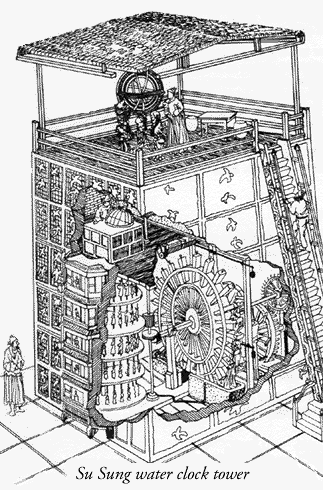The History of Horology and Chronometry
General History
Southern England
Stonehenge
County Meath, Ireland
3000 to 2500 BC
The Newgrange passage grave was constructed. It would flood with light on the Winter Solstice for 17 min.
Americas
Cuzco, capital of the Incas
Throughout the city, lines of sight provided a clear view of the Sun as it rose and set on important occasions
41 sightlines radiated from Coricancha (Temple of the Sun).
Mayan
There was an idea of cyclic time with time reversing direction at each sunrise and sunset.
Aztec
Tenochititlan was established in Lake Texococo in 1325
The Aztec had two calendars, one with 260 days and the other with 365 days. The combination of the calendars formed a 52 year cycle. The end of one cycle and the beginning of the next was signaled by a celestial event: the passage of the Pleiades through a specific location at night which signaled that the gods were pleased and would renew life’s cycle for another 52 years.
Native Americans
Medicine wheel (northern Wyoming)
Egyptians
3500 BCE
Created the earliest obelisk/gnomon (based on shadow)
1525-1504 BCE
The oldest Clepsydra found in tomb of Egyptian pharaoh Amenhotep I
1500 BCE
The world’s oldest sundial

600 BCE
Merkhet (oldest known astronomical tool)
- Made it possible to measure night hours
- Two merkhets were used to establish a north-south meridian; they were lined up with the Pole star
- Crossing of this meridian by certain stars indicated the hour

Persia
500 BC
Zeebad (Zibad), Iran used water clocks
- The Zeebad Gonabad water clock was used till 1965
328 BC
Persians use water clocks (Fenjaan) to ensure just and exact distribution of water from qanats (gently sloping underground water channels) to their shareholders for irrigation
- a bowl with a hole was placed in a big pot full of water; time was measured when the bowl filled up and sank
- the situation of the clock and managers collectively are called khaneh fenjaan

Greeks
325 BCE
Clepsydras (water thief, water clocks) were used by Greeks and described by Greek engineer Philo of Byzantium

150-100 BCE
Antikythera Mechanism: a mysterious mechanical device found in an ancient Greek ship
Description: the front dial has two concentric scales. The outer ring is marked off with the days of the 365-day Egyptian calendar, or the Sothic year, based on the Sothic cycle. Inside this, there is a second dial marked with the Greek signs of the Zodiac and divided into degrees. The calendar dial can be moved to compensate for the effect of the extra quarter day in the solar year (there are 365.2422 days per year) by turning the scale backwards one day every four years.

50 BCE
Macedonian astronomer, Andronikos, supervised the construction of Horologion, known as Tower of the Winds, in the Athens marketplace
30 BCE
Vitruvius could describe 13 different sundials in use in Greece, Asia Minor, and Italy
Chinese
500 – 900 AD
Candle Clocks were in use (mentioned in Chinese poem by You Jianfu and they are also attributed to King Alfred the Great)
725 AD
Clepsydra with incorporated water-driven escapement invented
1088 AD
Su Sung built elaborate clock tower, 30 feet tall, doors to reveal manikins which rang gongs or bells, or held tablets indicating the hour

1010-1012 AD
Atom is described as the smallest division of time
Byrhtferth's Enchiridion (a science text): 1/564 of a momentum (1½ minutes) = 15/94 seconds. It was used in the computus, the process of calculating the date of Easter.
1291
Prince Asulid of Yemen invents astrolabe (used to predict positions of sun, moon, planets, stars)

1348-1364
Giovanni Dondi dell’Orologio of Padova, Italy builds the Astrarium, a complex astronomical clock.

1352-1354
“Three Kings Clock” or the Strasbourg Astronomical Clock of the Strasbourg Cathedral was constructed. It has automata including a gilded crowing rooster.

1410
The Prague Astronomical Clock was constructed. It has a background illustrating the Earth and sky, an hourly clock, curved lines representing 1/12 of time between sunrise and sunset, a circle with zodiac signs, a small star which represents the vernal equinox, and it can read sidereal time. It is the 3rd oldest astronomical clock, and is the oldest in operation.

1632
Jean Toutin (French watchmaker) invents the technique of painting enamel for cases and dials
1640
Black Forest artisans produce the first mechanical clocks for the homes of the rising middle class
1655
Cassini builds the heliometer of San Petronio in Bologna in order to standardize the solar noon
1730
Black Forest Cuckoo Clocks are made
1731
John Hadley (English mathematician) made the first sextant

Early 1800's
Carriage Clocks also known as "Officer's Clocks" were made. The first one was created in Paris by Abraham-Louis Breguet (1812). The history of these clocks are as follows: Napoleon, having almost lost a battle because one of his officers was late, ordered his military chiefs to carry a small clock with them at all times. Orders placed with master clockmakers always included the reference “a clock for an officer” and this brought the name into common usage.

1802-1816
Eli Terry and his associates Seth Thomas and Silas Hoadley applied water-powered machinery to clock-making and pioneered the mass production and interchangeability of clocks and clock parts. In fact, they were able to complete a contract to make 4000 clocks while making 500 clocks at a time. They were based in Connecticut and were were inspired by Eli Whitney. The clocks were wooden, had long pendulums, and fit in traditional tall cases.
1816
Eli Whitney designed the distinctly American clock small enough to fit on a mantel or shelf which was largely sold to rural buyers
1830
Western Connecticut home to over a hundred firms for making clocks with wooden movements
1875
Nemitz discovered calcium sulfate as the first luminescent substance for numerals and hands
1890
Genevan Dialmaker A. Beyeler introduced ‘transfer press technology’ for applying numerals and names to dials